OCZ Vertex 3 (240GB) Review
by Anand Lal Shimpi on May 6, 2011 1:50 AM ESTAnandTech Storage Bench 2011
Last year we introduced our AnandTech Storage Bench, a suite of benchmarks that took traces of real OS/application usage and played them back in a repeatable manner. I assembled the traces myself out of frustration with the majority of what we have today in terms of SSD benchmarks.
Although the AnandTech Storage Bench tests did a good job of characterizing SSD performance, they weren't stressful enough. All of the tests performed less than 10GB of reads/writes and typically involved only 4GB of writes specifically. That's not even enough exceed the spare area on most SSDs. Most canned SSD benchmarks don't even come close to writing a single gigabyte of data, but that doesn't mean that simply writing 4GB is acceptable.
Originally I kept the benchmarks short enough that they wouldn't be a burden to run (~30 minutes) but long enough that they were representative of what a power user might do with their system.
Not too long ago I tweeted that I had created what I referred to as the Mother of All SSD Benchmarks (MOASB). Rather than only writing 4GB of data to the drive, this benchmark writes 106.32GB. It's the load you'd put on a drive after nearly two weeks of constant usage. And it takes a *long* time to run.
Here's a high level overview:
1) The MOASB, officially called AnandTech Storage Bench 2011 - Heavy Workload, mainly focuses on the times when your I/O activity is the highest. There is a lot of downloading and application installing that happens during the course of this test. My thinking was that it's during application installs, file copies, downloading and multitasking with all of this that you can really notice performance differences between drives.
2) I tried to cover as many bases as possible with the software I incorporated into this test. There's a lot of photo editing in Photoshop, HTML editing in Dreamweaver, web browsing, game playing/level loading (Starcraft II & WoW are both a part of the test) as well as general use stuff (application installing, virus scanning). I included a large amount of email downloading, document creation and editing as well. To top it all off I even use Visual Studio 2008 to build Chromium during the test.
Digging a little deeper, the test has 2,168,893 read operations and 1,783,447 write operations. The IO breakdown is as follows:
| AnandTech Storage Bench 2011 - Heavy Workload IO Breakdown | ||||
| IO Size | % of Total | |||
| 4KB | 28% | |||
| 16KB | 10% | |||
| 32KB | 10% | |||
| 64KB | 4% | |||
Only 42% of all operations are sequential, the rest range from pseudo to fully random (with most falling in the pseudo-random category). Average queue depth is 4.625 IOs, with 59% of operations taking place in an IO queue of 1.
Many of you have asked for a better way to really characterize performance. Simply looking at IOPS doesn't really say much. As a result I'm going to be presenting Storage Bench 2011 data in a slightly different way. We'll have performance represented as Average MB/s, with higher numbers being better. At the same time I'll be reporting how long the SSD was busy while running this test. These disk busy graphs will show you exactly how much time was shaved off by using a faster drive vs. a slower one during the course of this test. Finally, I will also break out performance into reads, writes and combined. The reason I do this is to help balance out the fact that this test is unusually write intensive, which can often hide the benefits of a drive with good read performance.
There's also a new light workload for 2011. This is a far more reasonable, typical every day use case benchmark. Lots of web browsing, photo editing (but with a greater focus on photo consumption), video playback as well as some application installs and gaming. This test isn't nearly as write intensive as the MOASB but it's still multiple times more write intensive than what we were running last year.
As always I don't believe that these two benchmarks alone are enough to characterize the performance of a drive, but hopefully along with the rest of our tests they will help provide a better idea.
The testbed for Storage Bench 2011 has changed as well. We're now using a Sandy Bridge platform with full 6Gbps support for these tests. All of the older tests are still run on our X58 platform.
AnandTech Storage Bench 2011 - Heavy Workload
We'll start out by looking at average data rate throughout our new heavy workload test:

The breakdown of reads vs. writes tells us more of what's going on:
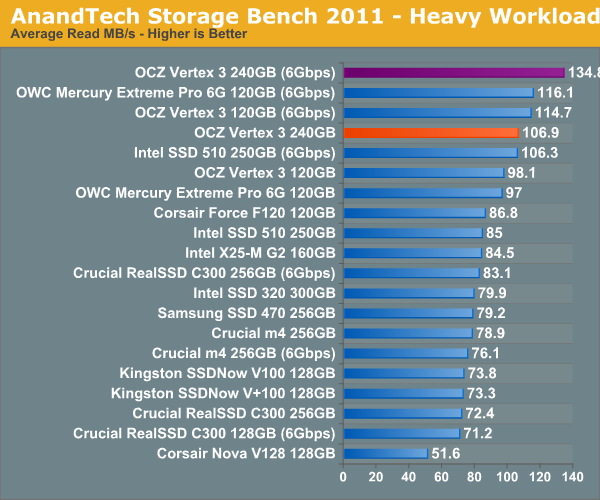
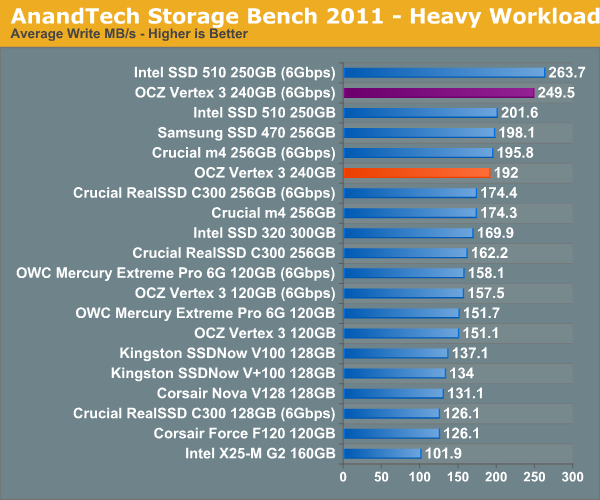
The next three charts just represent the same data, but in a different manner. Instead of looking at average data rate, we're looking at how long the disk was busy for during this entire test. Note that disk busy time excludes any and all idles, this is just how long the SSD was busy doing something:
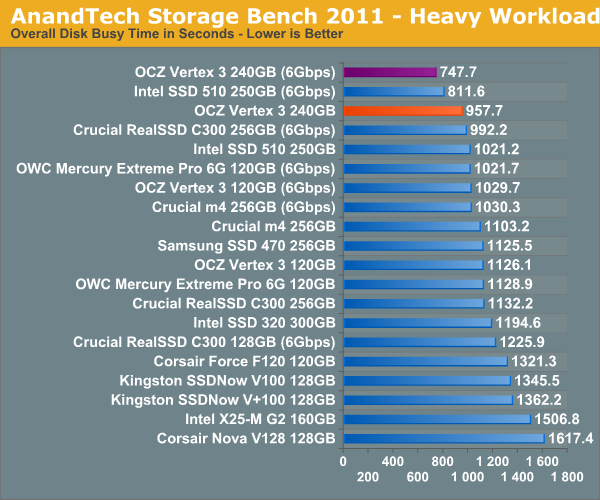
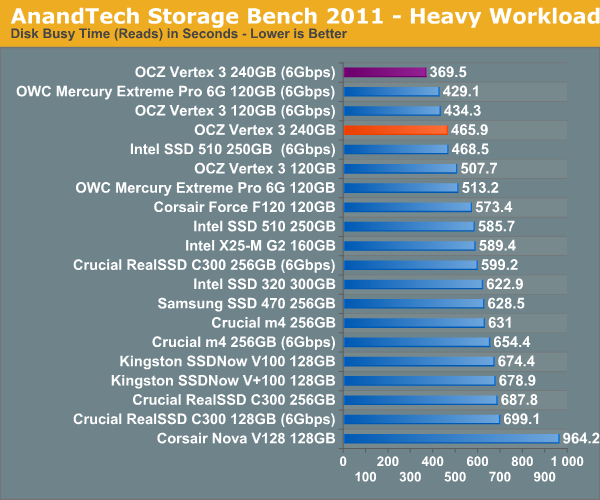
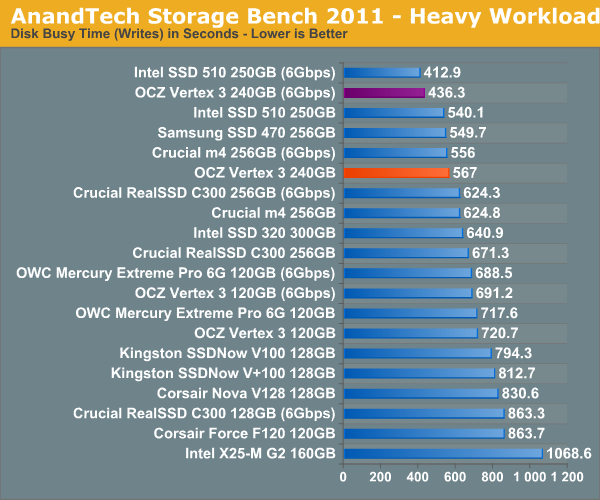










90 Comments
View All Comments
ggathagan - Friday, May 6, 2011 - link
Your takeaway is correct.I see a lot of comments in this and other SSD articles that talk about Sandforce not being ready for prime time.
As Anand has repeatedly mentioned, one of the drawbacks for a small, niche-technology company is an inability to match companies like Intel in the R&D arena.
The consumer, in essence, has been the R&D department for Sandforce.
When it comes to the average user, there are no performance examples that I can think of where a Sandforce-based drive will make enough difference to make it worth the risk over Intel.
Cutting edge technology is not worth it in this particular arena.
FunBunny2 - Friday, May 6, 2011 - link
-- When it comes to the average user, there are no performance examples that I can think of where a Sandforce-based drive will make enough difference to make it worth the risk over Intel.And, given that Enterprise data is frequently encrypted/compressed into databases, they won't be much use in Enterprise. Marvell might end up the winner as OEM controller vendor.
AlainD - Friday, May 6, 2011 - link
HiI've found that AS-SSD has a compression benchmark. Would be nice to add those to the reviews. Probably only 6GBps is usefull.
I'm surprised that the new sandforce controller is capable of sequential reading approx. 500 MB even if the data is compressed. Writing seems to be another story and then the AS-SSD compression benchmark could be some extra info.
Casper42 - Friday, May 6, 2011 - link
Bought my wife a new HP DV6T Quad Core Sandy and bought it with a traditional 640GB drive because I knew I wanted a (what I call) 3rd generation SSD which the dont offer yet.However, I noticed the Intel Storage Manager is in the System Tray and that leads me to beleive the Intel SATA driver is probably loaded too. I would think they wouldnt load this due to the previous issues with the driver breaking TRIM support under 7, but then thought perhaps they load a slightly different image on machines they ship with Factory SSDs.
Anyway, to cut to the point, Do the latest Intel SATA drivers still break Win7 TRIM support? Or has that all been fixed and I just wasn't paying attention?
Thx,
Casper
InsaneScientist - Saturday, May 7, 2011 - link
As of version 9.6 (march of last year, I think), yes the Intel drivers will work with TRIM if the drives aren't in a RAID array.Casper42 - Friday, May 6, 2011 - link
Due to the speed differences in the 120 vs 240 and the nature of SF drives and incompressible data.....I am wondering what your recommendation would be for a 120GB drive going into a Windows laptop that will be running a very traditional desktop software load. Not a lot of games, not a lot of Video Editing. Mainly just surfing the net and running Office type apps?
Budget is less of a concern than speed and reliability, but within reason. I will take a 10-20% hit on price to get a better product but approach 50% and things change.
anonapon - Friday, May 6, 2011 - link
I'm curious how this will affect SSD caching. When they come out, I'm hoping to put together a system as soon as possible with a Z68 board and I've been thinking about having a really great drive like the Vertex 3 as my system and application drive, either one 240 or two 120s in RAID0, and using a small and reliable but otherwise mediocre SSD to cache a single large mechanical drive; but, as far as I understand it, SSD caching will require the latest Intel 10.x RST drivers, and OCZ's firmware doesn't work with the latest Intel 10.x RST drivers.Is this other people's understanding as well, and does anyone know if there will be a solution soon?
mars2k - Monday, May 9, 2011 - link
I have IRST 10.xxx loaded F6 during clean Win7 SP1 x64 install on SB 2820QM, 240Gb Vertex3. Loaded Win 7 with a thumb drive. It took ten minutes or less from 1rst boot for the intall to browsing the internet. Way cool!I am experiencing some hangs. There is a fix for this on the OCZ forums. Will try.
BLU82 - Friday, May 6, 2011 - link
Great review as always Anand, but have a couple of questions for you. Do you know if you will get a sample of the 480GB V3? Not that any of us could afford one, but since these are parallel devices I would be interested to see how its performance would stack up against the 120 and 240. I am assuming that they just use the "J" designated chips over the "C"???Also, do you know what differences the newer "Max IOPS' versions would perform over these first releases? I returned a vanilla 120GB version right after I saw where OCZ introduced the MAX IOPS version but still not sure whether to go that route, try and RAID 0 two 120GB vanilla versions, MAX IOPS version, or get one 240GB vanilla or MAX IOPS version??? I liked the 120GB version and really find it hard to try and run my Sandy Bridge on a Velociraptor again, but since it was a first release and what you pointed out between the 120 and 240 versions made me think I should have just waited on a 240. But man, that price tag. Which, brings me back to the 480GB version. Don't hear anyone talking about it (due to the price I'm sure), but I would be very curious about the performance and if there are any differences between it and the 240.
Thanks again Anand. I've actually been reviewing your site since it's inception way back in the mid-late 90's. You do a great job and always have.
neotiger - Saturday, May 7, 2011 - link
In your random read benchmark, Vertex 3 120GB clocked in at 35MB/s while Corsair Force 120GB achieved a much better performance at 58MB/s.Corsair Force actually use the last generation of SandForce. So why is the new generation of SandForce so much slower than the last generation product?
Was there an error in the benchmark?